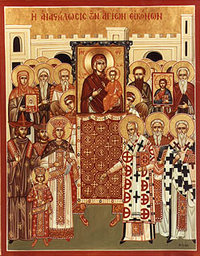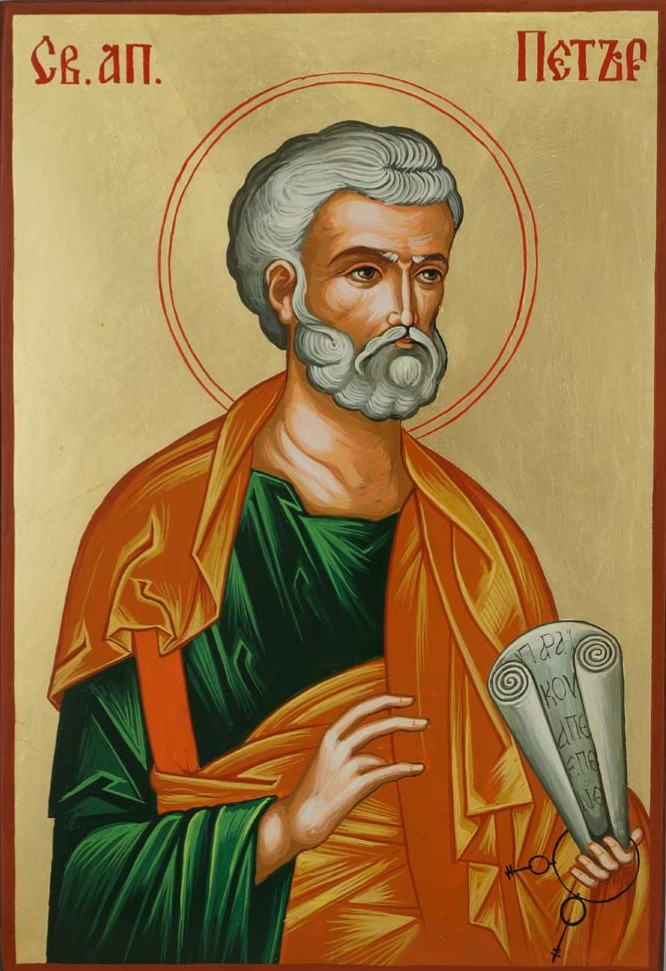
February 21, 2010
On this day we celebrate the Triumph of Orthodoxy, the commemoration of the defeat of the heresy of iconoclasm. The word “heresy,” as we know, means “false teaching” and the false teaching that was finally vanquished was iconoclasm.
“Iconclast” comes from the Greek work that means “icon-breaker.” The iconoclasts were those who smashed the icons because they believed that the Orthodox faithful, in venerating icons, were breaking the first commandment that says, “Thou shalt not make unto yourself any graven image.”
Of course the objection ran deeper than that. Look at it closely and you see that the false teaching – the heresy – of iconclasm taught something else too. It taught that Jesus Christ never really existed. The second person of the Trinity, the Word — capital W — of the Father never really became flesh and dwelt among us.
And that is why the Orthodox leaders fought the heresy. If the Word did not become flesh and dwell among us, then we believe a lie. Salvation does not really exist. We are deceivers who are deceived.
The iconoclasts were wrong in this way: When the Word became flesh and dwelt among us, you could make an image of Him because He existed just like you and I do – in space and time. Jesus had flesh and blood – just like you and me. He was not a phantom or just a figure in our imagination.
And that is why creating an icon of Jesus Christ is allowed. In fact, St. Paul tells us in scripture that Jesus the Son is the – and I am looking at the English here – “express image” of the Father. Look this up in the Greek and the word is eikon — or “icon.” We are allowed to make an icon of the Eikon, an image of the Image.
So, if you were around two thousand years ago and had your digital camera with you, you could have taken a picture of Jesus and His image could be printed out on paper. He wasn’t an imaginary figure. He wasn’t a concept. He was nothing less than a flesh and blood human being. And, like the faithful of old, you would venerate that image because He was also the Son of God.
This service, the one we celebrated today was first held in 842 in Constantinople. Patriarch Methodios presided and the faithful Empress Theodora was in attendance. It has been held every year on the first Sunday of Lent in every Orthodox Church every year ever since.
+++++++
But there is a deeper lesson for us too. And the lesson is this: Every generation faces its own heresies – its own false teachings – that require a defense drawn from the faith.
In America we face them too although in different ways. America is a great country. It has grasped some principles about human freedom and liberty that, at their core, are Christian in their origin. But we are not an empire or a monarchy. We are not mono-cultural. We are a nation of immigrants who govern ourselves not as a tribe, but under the rule of law.
So things work differently here. We have no emperor. We have no patriarch — at least not yet. We have the public square to debate and settle our differences, and that public square is often a noisy, raucous, and sometimes unfair place.
Do you wonder why moral questions become political issues sometimes? That’s why. Do you ask yourself why people get so emotionally invested in what otherwise would be private affairs? That’s why too. Do you wish that sometimes the emotional temperature could be lowered a few degrees? I do too but usually it doesn’t happen.
And there are huge questions being debated today. Gay marriage, what constitutes a family, greed in the marketplace, our relationship to the environment, who should live and who should die – all sorts of question that portend a very different society down the road depending on how they are answered.
But here too we have to take a closer look. And if you look closely, past the immediate political posturing on the many sides of these issues, you see that they pose this common question: What does it means to be a human being? From the Christian point of view we would sharpen that question even further: Who did God create us to be?
In theological language — and I am going to throw out a thirty-five dollar theological term here — we call this an “anthropological” question. “Anthropological” comes from the Greek work anthropos which means, “man.” The question behind many of the questions in our culture today is really a question about what it means to be a human being – Who did God create us to be?
From that question flow a thousand others that crystallize around a handful of secondary ones — How do I understand myself? How do I understand others? How do I relate to others? How to I relate to the physical world around me? What is my responsibility to my neighbor?
+++++
Let me shift gears. I said earlier that this celebration — the Sunday of Orthodoxy — commemorated the restoration of icons that was really the restoration of the Orthodox faith. I also said that every generation faces the heresies — the false teachings — in its own time and way. I said too that in America, we have these great conflicts but they express themselves in a different way.
With that in mind, in America, the Sunday of Orthodox is also the time we discuss Orthodox unity – the goal of having one unified Orthodox Church in America.
I believe the time has come that if we do not have unity, Orthodoxy in America will never reach its God-given commission to bring the kind of light to this great nation that can heal it – that can answer in intelligent and compelling ways the core questions that frame so many great debates in the public square.
I also believe that the objections we hear to Orthodox unity have become largely irrelevant for this reason: your children and grandchildren are American. If Orthodox Christianity cannot reach them as Americans — which is to say that if it cannot speak to them in the cultural context that the Orthodox of old reached their children in their particular cultures — the Church will not die (it never dies), but Orthodoxy in America will retrench and fade into a cultural and religious oddity much in the same way that we think about the Amish or the Shakers.
Our children and grandchildren are American. Nothing will change that. If the Church will not incorporate the Orthodox faith into American culture, it won’t have anything to say to them and they will look elsewhere for the living water. And God, being a good God who loves mankind – phil-anthropos-translated as “the lover or mankind” or sometimes “the friend of man” — just might find another way to give it to them.
Orthodoxy has always been closely tied to culture. In fact, you can’t have religion with a corresponding cultural expression of it. Put another way, religious faith enervates, vivifies, makes alive, the culture in which we live. Religion is the ground of culture. The tradition is the structure that shapes culture so that culture itself points to and references the deepest truth of all – the Gospel of Jesus Christ.
So I join my voice with those who — on this day in years past and in many churches all over America today — call for the Orthodox in America to embrace the Gospel commission to go forth unto all nations to preach and baptize. Orthodoxy, which its rich comprehension of the Gospel of Jesus Christ is coming of age in a new, young, and very vibrant country that is being prepared to hear this gospel and thereby have new life breathed into it.
We see Orthodoxy in America coming of age at the same time that America is in a deep cultural crisis. I do not believe this is a historical accident. I believe that God brought the Orthodox faith to America to speak to a nation that needs new life breathed into it at the proper time. That time is now.
And if we respond, then we are faithful to the legacy bequeathed to us that we celebrate today. Then we can stand with the assurance and resolve that we too are meeting the challenge of our generation in the same way that the Orthodox did over 1200 years ago.
